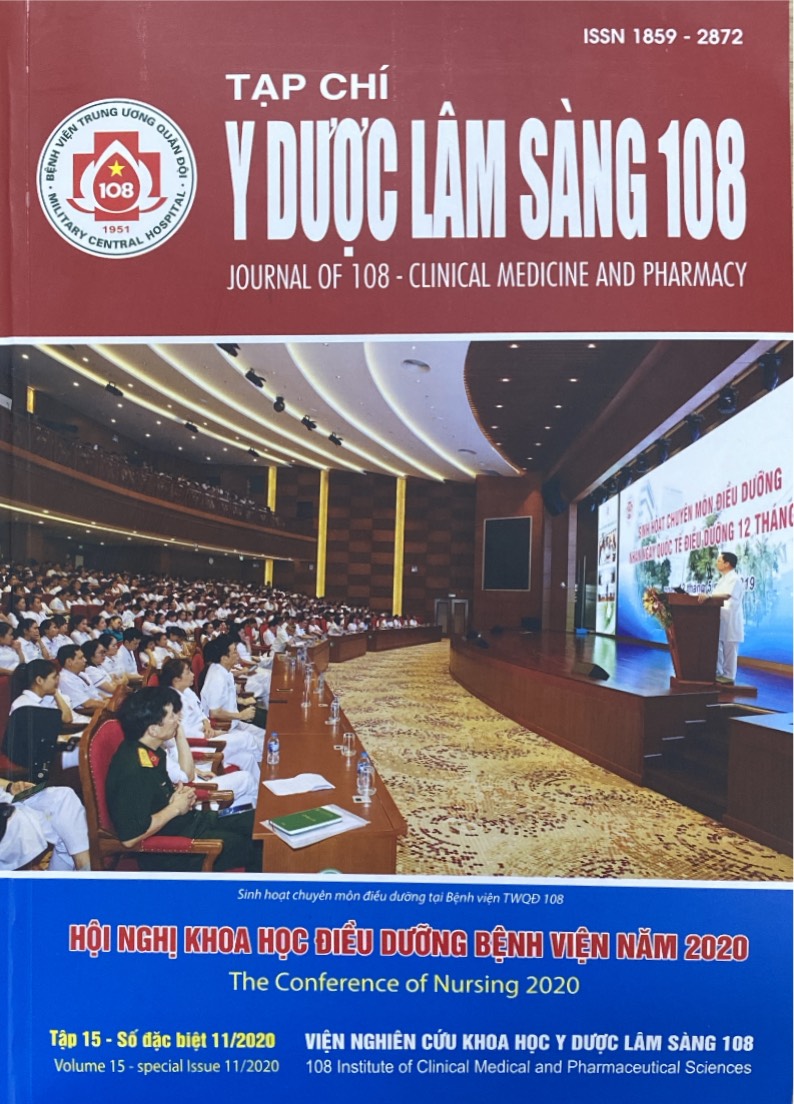Evaluation of weight, transverse diameter and volume changes after 20 fractions of intensity-modulated radiotherapy for patient with nasopharygeal carcinoma
Main Article Content
Keywords
Abstract
Objective: To evaluate changes of the weight, transverse diameter and volume after 20 fractions of intensity-modulated radiotherapy (IMRT) for patients with nasopharygeal carcinoma (NPC). Subject and method: A retrospective study of 63 stage II-IVB NPC patients received IMRT concurrently with triweekly cisplatin from September 2016 to March 2020 at 108 Military Central Hospital. Patients received a new computed tomography simulation after 20 fractions. Result: The weight, transverse diameter of the nasopharyngeal, the neck, GTV-tumor, GTV-lymph node, CTV and 2 parotid glands volume were decreased significantly at time after 20th fraction compared with before treatment (mean reduction 3.79 ± 2.29kg, 0.77 ± 0.48cm, 0.79 ± 0.63cm, 6.25 ± 7.82cm3, 12.37 ± 16.37cm3, 38.93 ± 31.83cm3, 5.65 ± 4.57cm3, 6.14 ± 4.92cm3, respectively; p=0.0001). The transverse diameter of the nasopharyngeal, the neck reduction were significantly correlated with 2 parotid glands volume reduction (r = 0.76, p=0.0001, r = 0.69, p=0.0001, r = 0.66, p=0.0001 và r = 0.65, p=0.0001, respectively). However, no significant correlation was observed between weight loss and GTV, CTV, 2 parotid glands volume reduction. Conclusion: The significant reduction in transverse diameter of the nasopharyngeal, the neck, GTV-tumor, GTV-lymph node, CTV and 2 parotid glands volume suggests the need for replanning after 20 fractions during IMRT with NPC
Article Details
References
2. Al-Sarraf M, LeBlanc M, Giri PG et al (1998) Chemoradiotherapy versus radiotherapy in patients with advanced nasopharyngeal cancer: Phase III randomized Intergroup study 0099. J Clin Oncol 16(4): 1310-1317.
3. Bray F, Ferlay J, Soerjomataram I et al (2018) Global cancer statistics 2018: GLOBOCAN estimates of incidence and mortality worldwide for 36 cancers in 185 countries. CA Cancer J Clin 68(6): 394-424.
4. Chen YP, Chan ATC, Le QT et al (2019) Nasopharyngeal carcinoma. Lancet 394(10192): 64-80.
5. Hunt MA, Zelefsky MJ, Wolden S et al (2001) Treatment planning and delivery of intensity-modulated radiation therapy for primary nasopharynx cancer. Int J Radiat Oncol Biol Phys 49(3): 623-632.
6. International Agency for Research on Cancer - World Health Organization. GLOBOCAN 2018: Viet Nam - Global Cancer Observatory Available from: https://gco.iarc.fr/today/data/factsheets/populations/704-viet-nam-fact-sheets.pdf, [cited 2020 13 August ].
7. Ozdemir S, Akin M, Coban Y et al (2015) Acute toxicity in nasopharyngeal carcinoma patients treated with IMRT/VMAT. Asian Pac J Cancer Prev 16(5): 1897-1900.
8. Yan D, Yan S, Wang Q et al (2013) Predictors for replanning in loco-regionally advanced nasopharyngeal carcinoma patients undergoing intensity-modulated radiation therapy: A prospective observational study. BMC Cancer 13: 548.
9. Yang H, Hu W, Ding W et al (2012) Changes of the transverse diameter and volume and dosimetry before the 25th fraction during the course of intensity-modulated radiation therapy (IMRT) for patients with nasopharyngeal carcinoma. Med Dosim 37(2): 225-229.
10. Yang H, Tu Y, Wang W et al (2013) A comparison of anatomical and dosimetric variations in the first 15 fractions, and between fractions 16 and 25, of intensity-modulated radiotherapy for nasopharyngeal carcinoma. J Appl Clin Med Phys 14(6): 3918.
 ISSN: 1859 - 2872
ISSN: 1859 - 2872
